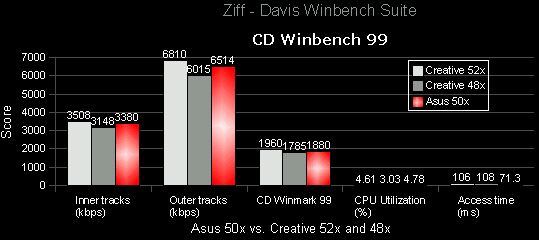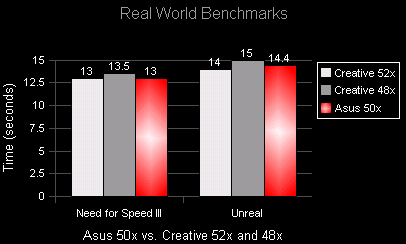
At first glance, the results are something one would normally expect
from a 50x drive. The performance in the inner and outer tracks lie
pretty much between the 52x and the 48x drives. The same could be said for the CD
Winmark scores. CPU Utilization is a bit higher on the Asus 50x
drive.
The performance differences are not very dramatic under this
benchmark. The number to look out for is the CPU access time of the 3 drives
where the Asus 50x comes out the clear winner. We all know that in hard disks,
the access times are so low already that 1-3 milliseconds do not make much of a
difference in overall hard disk performance. When turning to CD-ROM drives, the
story is a bit different.
In fact, the Asus 50x drive's access is up to 30ms+ lower than 2
drives compared. After one of the tests, this benchmark suite reported the
access time to be as low as 68.5ms! So what am I getting at? You will see the
explanation later on after the real world benchmarks are displayed.

Both installations of NFS 3 and Unreal were set at minimal,
meaning that only the bare files needed to run these games were installed on the
hard drive. The remaining files are to be read from the CD-ROM. The games were
loaded into the main menu and the time taken during both games was from
selecting a new game till the time the game was loaded.
Not much of a
difference in this area. Though it is interesting to see that the performance of
the 50x leans towards the performance of the 52x rather than the 48x drive.
CD speed
explanation
Before moving further it should be
made clear why certain CD-ROM drives rarely (rather never) sustain their rated transfer speeds. Many
CD-ROM drives on the market are label as 48x MAX or 50x MAX, etc. The
MAX part of it doesn't really signify the name of the drive but rather describes that
the rated speed is the maximum attainable transfer rate of the CD-ROM drive.
In order to understand what they mean by maximum attainable transfer rate, you must be aware of
the way that the CD-ROM spins and the way the CD-ROM
drive reads. The outer edges of a given CD "spin faster" than the inner edges of
the CD.
As the
circumference of the outer parts of a CD are greater than the inner areas, at a
given RPM, more data can be read off of the outer edges of a CD per revolution
than the inner edges. There are two methods which are utilized by CD-ROM drives
known CLV and CAV.
CLV, or Constant Linear Velocity is a method which
describes the way a CD-ROM drive reads a CD. In CLV, the CD rotational speed is
adjusted in order to maintain a constant rate of data transfer on both the inner
and outer edges of a CD-ROM. As mentioned above, the outer edges of a CD-ROM
drive are read faster than the inner edges. A CD-ROM drive which exploits the
use of CLV means that the CD will spin slower at the outer edges of a CD-ROM and
faster at the inner edges in order to keep data transfer rates constant. So this
means that a 24x drive utilizing CLV will read data at a 24x transfer rate all
of the time.
The other method is known as CAV,
or Constant Angular Velocity. Instead of varying spin speeds, CAV keeps the RPM
of a CD constant and reads data at whatever speed is being delivered. Taking a
40x MAX CD-ROM as an example, the data transfer rate at the inner edges of a CD
might only be 18x-20x as data transfer rates are slower in that region.
On the
other hand, when the lens is reading data from the outer edges of the CD,
transfer rates increase up to the maximum rated speed. This is where the MAX
term comes into play and why drives labeled with MAX do not transfer data
constantly at their rated speed. The Creative 50x drive is an example of a CAV
type CD-ROM drive. By look at the benchmarks above and after reading this
explanation, you should now understand why the inner track speed is slower than
the outer track speed on this type of CAV-based mechanism.
